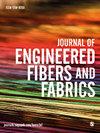Role of knitted techniques in recent developments of biomedical applications: A review
IF 2.3
4区 工程技术
Q1 MATERIALS SCIENCE, TEXTILES
引用次数: 0
Abstract
All the surgical bandages, extracorporeal devices, and prosthetic implants that we use today are the product of textiles. Because they conform well to the body and feel good against the skin. Woven, non-woven, and knitted are only textile fabric construction methods. Among all, the knitted structures are more breathable and simpler to produce. In the previous two decades, knitting technology has advanced, now it is simple to create customized flexible and cost-effective biomedical devices. Knitted structures are increasingly used in implantable textiles like hernia and heart patches etc. due to their comfort, optimal strength, and ability to ravel from the last loop. The porous structure of knitted fabrics is particularly well suited for the transport of drugs. Since the knitted pattern, yarn effect, and dimensional parameters of fabric are all displayed in the 3D simulation software like Apex-lll and M-1, there is no longer any need to use actual fabric for quality control purposes, which greatly aids in reducing fabric waste. This article offers recent research on knitted fabrics including their advantages, disadvantages and future solutions that could be achieved by using advanced knitting manufacturing technologies. In addition, it calls attention to the significance of knitted structure in biomedical applications which may motivate further research into materials of this kind in the future.针织技术在生物医学应用的最新发展中的作用:综述
我们今天使用的所有外科绷带、体外设备和假体植入物都是纺织品的产品。因为它们能很好地贴合身体,而且对皮肤感觉很好。机织、非织造和针织只是纺织织物的构造方法。其中,针织结构更透气,生产更简单。在过去的二十年里,针织技术已经很先进,现在可以简单地创建定制的灵活且具有成本效益的生物医学设备。针织结构由于其舒适性、最佳强度和从最后一圈解开的能力,越来越多地用于疝和心脏贴片等植入式纺织品。针织织物的多孔结构特别适合于药物的运输。由于织物的针织图案、纱线效果和尺寸参数都显示在Apex lll和M-1等3D模拟软件中,因此不再需要使用实际织物进行质量控制,这大大有助于减少织物浪费。本文介绍了针织物的最新研究,包括其优点、缺点以及利用先进的针织制造技术可以实现的未来解决方案。此外,它还提醒人们注意针织结构在生物医学应用中的重要性,这可能会激励未来对这类材料的进一步研究。
本文章由计算机程序翻译,如有差异,请以英文原文为准。
求助全文
约1分钟内获得全文
求助全文
来源期刊

Journal of Engineered Fibers and Fabrics
工程技术-材料科学:纺织
CiteScore
5.00
自引率
6.90%
发文量
41
审稿时长
4 months
期刊介绍:
Journal of Engineered Fibers and Fabrics is a peer-reviewed, open access journal which aims to facilitate the rapid and wide dissemination of research in the engineering of textiles, clothing and fiber based structures.
 求助内容:
求助内容: 应助结果提醒方式:
应助结果提醒方式:


